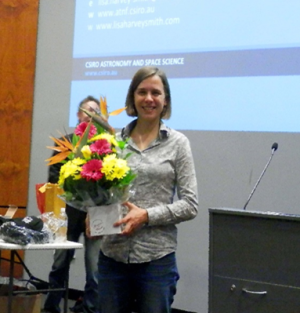Year born: 1979
Research Areas: Radio Astronomy, Supermassive Black Holes, Stellar Evolution
“When I get to inspire people who then write to me afterwards and say ‘you’ve really inspired me, you’ve made me want to study astronomy at university’ I just think that’s incredibly rewarding and I love it!”
Source: Science.org.au

Early Life
Lisa was born in Essex, UK. As a child, she was outside with her dad one night when they saw the planet Mars in the sky. This sparked Lisa's love of space, and she joined her local astronomy group to learn more. As part of the group, Lisa was able to use a telescope for the first time. She decided that when she was older, she would be paid to be an astronomer. When Lisa was 11, she left school. She learned at home until she went to Newcastle University to study Physics with Astronomy and Astrophysics. She then moved to the University of Manchester to study for a PhD in Radio Astronomy at Jodrell Bank Observatory.
Career Highlights
Lisa is a professor at the University of New South Wales, in Australia. She is now a British and Australian citizen. Lisa uses radio telescopes to study how the biggest stars in our galaxy formed. She is also interested in what happens when galaxies collide.
Radio astronomy uses the radio waves which stars and galaxies give off. Radio waves are a type of light our eyes can't see. Specially designed radio telescopes can collect radio waves. They turn the radio waves into information for astronomers to view and study. So a radio telescope lets us see things which a normal telescope would miss. Another benefit is that a radio telescope can observe for 24 hours a day, not just at night. A challenge of this kind of astronomy is that you need a huge telescope.
Lisa focused her career on improving the research tools used by radio astronomers. After leaving Jodrell Bank she worked in Germany and the Netherlands. She then moved to Australia when she has stayed ever since. Lisa was a lead scientist in the planning and development of the Square Kilometre Array (SKA) telescope. Once the SKA is finished, it will be 50 times more sensitive than any existing radio telescope. It will be able to survey the sky 10,000 times faster than ever before. Lisa was also part of the team who successfully bid to host the SKA in Australia.
Legacy
Lisa is the Australian Government’s first Women in STEM Ambassador. Her job is to increase the number of women and girls in Science, Technology, Engineering and Maths (STEM) courses and careers. In 2016, she won a prize for promoting public knowledge and awareness of science.
Other Interests
Lisa is a regular presenter on stargazing programmes. She has appeared on TV in Australia and in the UK. Lisa also writes popular science books about stars and space. She has written for adults as well as children.
